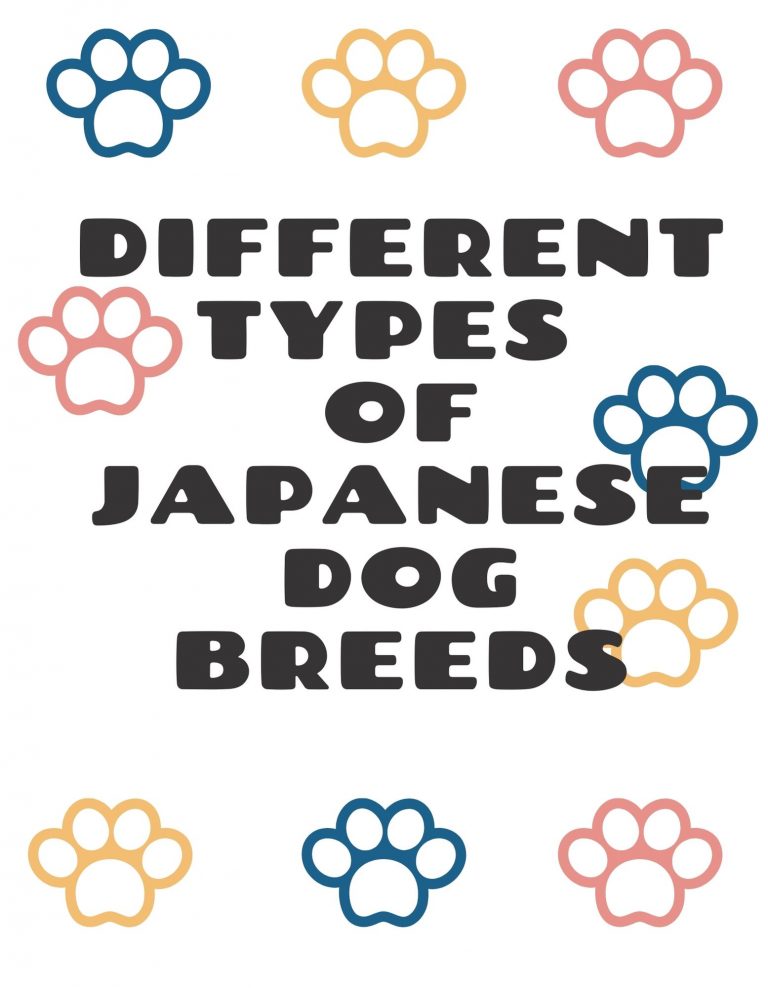Different Types of Korean Dog Breeds

“Dogs are not our whole life, but they make our lives whole.”
If you are a dog lover and want to know about the Korean dog breeds, you’ve come to the right place. This article will provide you detailed information about native Korean dogs you wish to know.
A dog is defined as a domesticated carnivorous mammal with an acute sense of smell, long snout, non retractable claws, and a barking whining voice. Dogs are considered as man’s best friends and almost every household owns one.
Most Korean dog breeds are already extinct. This is because eating dogs has been South Korea’s long-established tradition. In fact, this country has been ingesting dog meat for thousands of years. They considered dogs as livestock animals and became part of their food habits.
But in an effort to save and preserve these unique dog breeds, organizations all over the country designed programmes that serve as guides to aid dog owners and other animal institutions.
Below are the 7 Korean dog breeds you might want to get acquainted with.
Different Types of Korean Dog Breeds
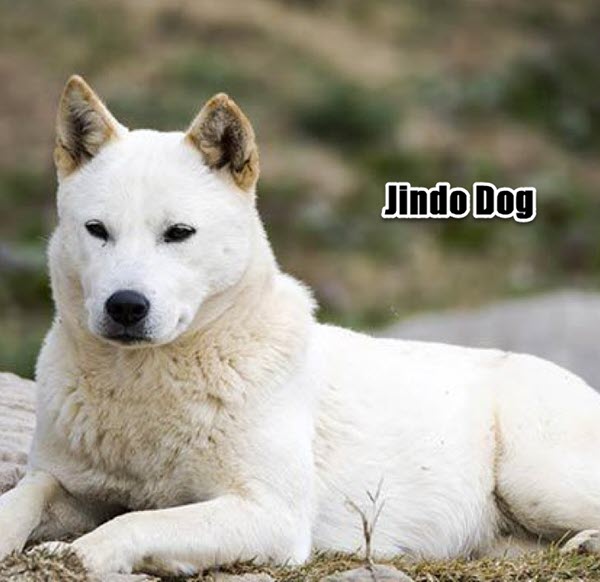
Jindo Dog
Korean Jindo is an ancient breed that is incredibly energetic. Jindo dog breeds are hunting dogs and also great companion pets. The Jindo breed is native to South Korea and is considered as one of the country’s national treasures. This great hunting dog is extremely intelligent. Thus, making it stand out from any other dogs. Even if Jindo specializes in pack hunting, this breed is hydrophobic. Therefore, refuse to cross flowing water or wander out of the rain with or without a guide.
Same breed had also marched in the 1988 Summer Olympics where more than a hundred of them walked in the opening ceremony held in Seoul, Korea. Also in 2008, The Jindo Dogs Guild (responsible for monitoring Jindo’s population in Korea), issued the Korean Jindo dog purity certificates.

Jeju Dog
Jeju dog, also known as JejuGae, Chaeju, and Cheju, is a breed of dog found in the island of Jeju in South Korea. This breed was brought back from the brink of extinction way back 1986, when only three of these dogs remained alive. But as of 2010, these dogs are still the rarest breed that originated from South Korea, where only 69 pure breds existed.
This Korean dog breed is protective, agile, and loyal just like the Korean Jindo. Jeju dogs are also considered as one of the largest native Korean dogs. These dogs have wide and pointy foreheads. Male Jeju is similar to a wolf while the female one looks like a fox.
This breed is also one of the most consumed dog breeds in Korea, that is why these dogs faded so rapidly. Jeju dogs were also once used in the Southern Korean Military for different jobs like search and rescue.
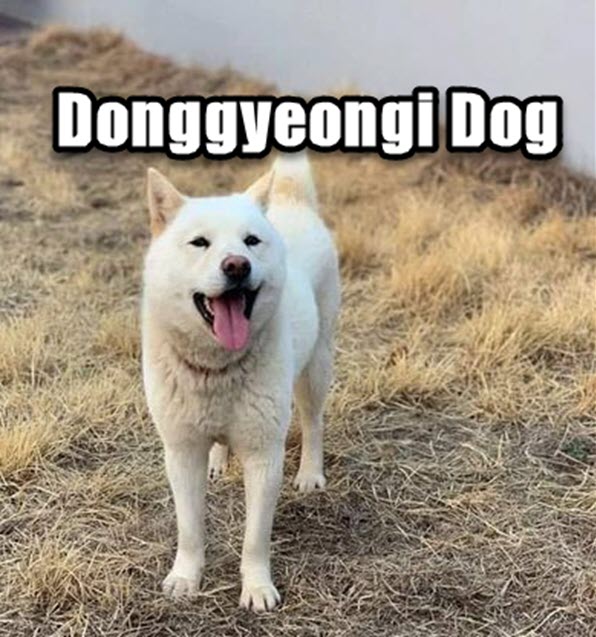
Donggyeongi Dog
Donggyeongi dog, also known as daeng gyeon or Donggyeong gae, is native to Korea. This endangered dog breed with a total of about 600 dogs, has been protected in South Korea since 2012. It is considered as a natural treasure in the country. Donggyeongi dog breed with a bob-tailed dog is named after Gyeongju, Korea, the place where the breed originated. This short-tailed Korean breed dog is dependable, friendly, and devoted. Its physical appearance is similar to Jindo dog.
After the great efforts made by the locals to preserve this dog breed, Donggyeongi dogs were brutally slaughtered by the Japanese who invaded Korea in the early 20th century. The Japanese believed that this type of dog bears a resemblance to the Japanese Komainu. And instead of being delighted, this resemblance somehow offended the nation. Thus, the unfortunate massacre happened.
And even after Korea’s liberation in 1945, the deprivation of these breeds had worsened. The dogs’ short tails are viewed by the breeders as deformation and believed to bring bad luck. This is the reason why Donggyeongi dog ownership diminished.
Nevertheless, Donnggyeongi breed are excellent companion dogs. The dogs’ decent size made them ideal to become excellent guard dogs.
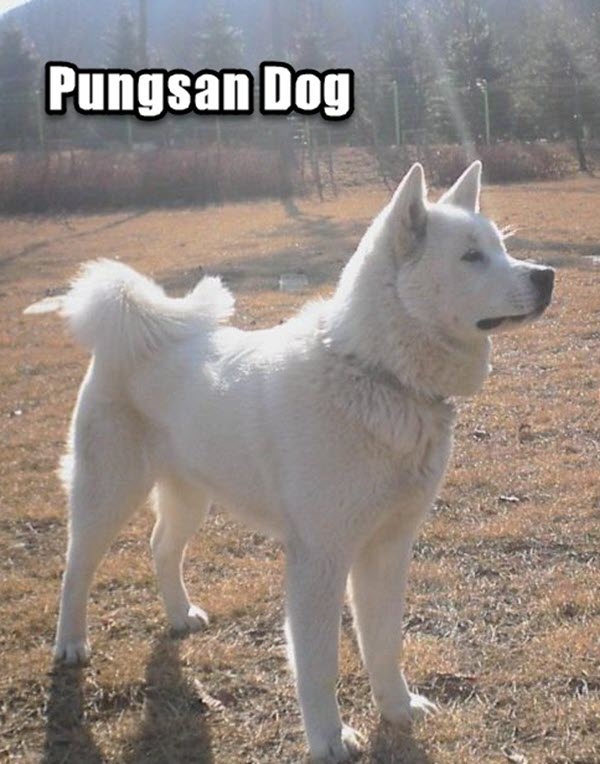
Pungsan Dog
Pungsan dog is also among the Korean breeds that may steal your interest. Pungsans are known to be stubborn, lively, and authoritative. This Korean dog is the only dog that originated in North Korea. These skillful hunting dogs were originally bred in the Kaema Plateau of North Korea. Pungsan dogs are also a rare breed with medium or double coat hair. They have been recognized as the solemn national dog of the Hermit Kingdom.
During the Inter-Korean Summit in 2000, Kim Jong-il, the former leader in North Korea gave 2 white pungsan dogs to the South Korean president, Kim Dae-jung, as a peace offering. And these dogs resided in the Blue House of the South Korea’s president for a couple of years and were honored as guests of the state.
Note that Pungsan breed dogs are not easy to take care of. Since these dogs tend to have a dominant personality, even pet lovers find it hard to go easy with them. Indeed, ownership is only recommended for skillful dog trainers. According to some local folklore story, Pungsan dog has taken down a Siberian tiger. Basically, the Pungsan dog is not an ideal companion pet but rather a reliable alpha dog.

Korean Dosa Mastiff Dog
Korean Dosa Mastiff is another Korean dog breed originated in South Korea. This Korean mastiff, also known as Mee Kyun Dosa, may look fearsome because of its wrinkled and heavy-built body structure, but can easily get devoted to its master. The Korean Dosa dog is also one of the rarest breeds. This sweet-natured Korean Mastiff dog is the most expensive dog that was exported to India.
This pack dog also needs to undergo obedience training during its younger age as this type of dog tends to be sluggish. Therefore, teaching an adult dog becomes tough.
Though the Korean mastiff is frightening because of its big size, this breed is actually the opposite. It is extremely friendly and is great around children. Korean Mastiff dogs also can easily get along with other dogs. The Dosa dog is also the largest dog breed which can reach up to 185 pounds in weight.
Korean Mastiffs are believed to be developed by cross breeding various European working dogs which includes Saint Bernard, English Mastiff, and Dogue de Bordeaux.

Sapsali Dog
Another type of Korean dog breeds that dog lovers fell in love with is the Sapsali dog. It is a shaggy dog from South Korea that is very patient, affectionate, and obedient. Its long shaggy coat resembles a small lion cub. Because of this, some locals refer to Sapsali dogs as “lion dogs”.
Sapsali is a medium sized dog with a bulky and tall body structure. Its hair usually covers its eyes, and comes in different colors like gold, grey, brown, black, or blend. This native Korean dog has also been declared as the country’s National Treasure in 1992. However, it has not been recognized yet by any major kennel clubs like the American Kennel Club and United Kennel Club.
Sapsali was also a popular Korean dog during the supremacy of the Silla Kingdom. Due to the admiration of the noblemen for these dogs, they were signed up in the Silla military and worked as all-around working dogs.
It was also believed that this dog breed in Korea has the power to push back evil spirits. These dogs that have exceptional patience are also called “ghost dogs”. And since this Korean dog breed is friendly and easy to get along with kids and other animals, it is not ideal to become a guard dog or a hunting dog like the Jindo dog.
According to history, these dogs were slaughtered by Japanese military troops that resided in Manchuria and became extinct after the Korean war. After the unfortunate killings, Salsi dogs were revived from the 8 remaining dogs.
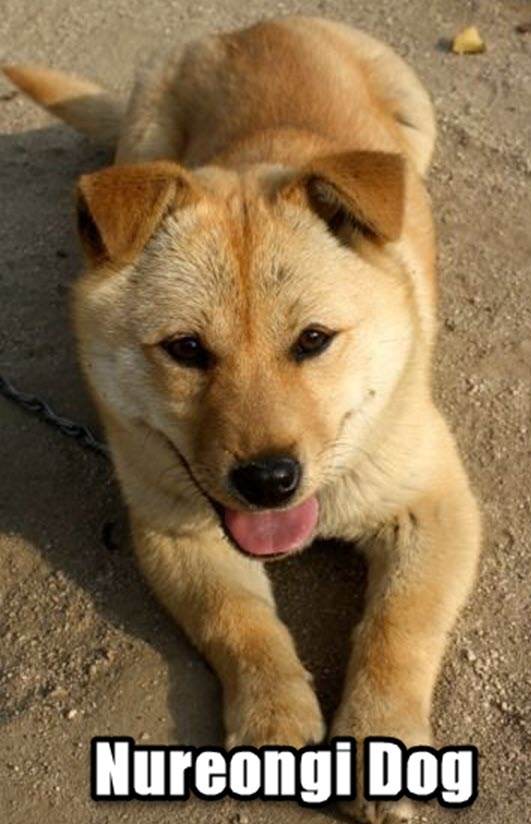
Nureongi Dog
Another dog that should be added in the Korean dog breeds list is the Nureongi dog. These Korean dogs are mongrel dogs with yellowish or golden hair. The term Nureongi basically means “yellow one”. The Nureongi dog from South Korea, which is also known as Korean yellow spitz, is sociable, friendly, and calm. This Korean breed is also nearly the same as the Jindo dog, but differ in traits and physical appearance.
During the ancient times of the 1st century AD, Korea had an old tradition called “Gaegogi”. This tradition is about consuming dog meat, and unfortunately, Nureongi is the most in demand breed to consume. With the help of the animal activists who fought back to end the eating dog meat tradition in Korean culture, this practice had ended.
OTHER POPULAR DOG BREEDS IN KOREA
TOSA INU, also known as Canis lupus familiaris, is a dog breed native to Japan but is popular in South Korea predominantly as a meat source. It is also a type of a fighting dog initially bred in Tosa, Shikoku. The ownership of this breed has been restricted in other countries because these dogs are considered a dangerous breed.
WRAP UP
So these are some of the rare and exotic dog breeds you can find in Korea. Despite the tragic condition these dogs have been through, their numbers are steadily rising. Dog ownership in Korea has also increased while dog meat consumption is diminishing. Thanks to the various kennel clubs and other organizations who play a vital role in protecting the welfare of these animals as well as revamping their population.
